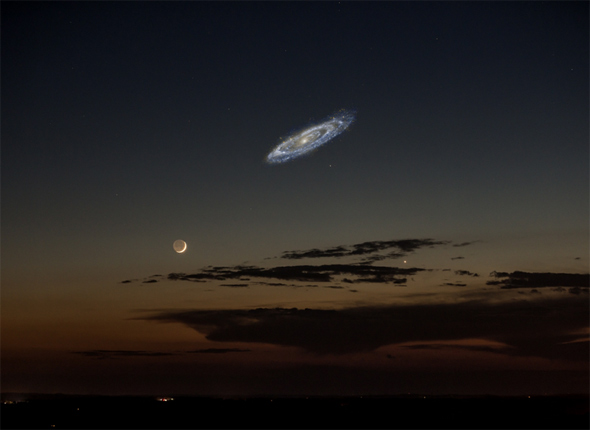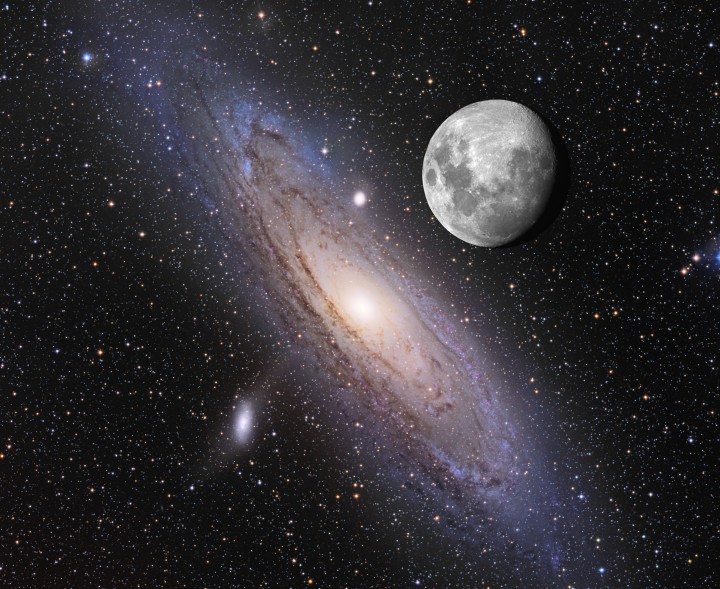Science
Related: About this forumYes, That Picture of the Moon and the Andromeda Galaxy Is About Right
By Phil Plait
In my line of business—trying to spread the word about science and trying to grind anti-science under my heel—I post a lot of articles with the word “no” in the title. “No, There’s No Proof of a Giant Planet in the Outer Solar System”, “No, Mars Won’t Be as Big as the Moon. Ever.”, “No, the Earth (Almost Certainly) Won’t Get Hit by an Asteroid in 2032”, and “No, We Are Not in a Climate ‘Pause’.”
Sometimes I wind up having to debunk viral pictures or videos getting spread around, too, which are very difficult to extinguish. That’s why I’m pretty happy to be able to write about one that’s actually pretty much correct!
The picture shows the crescent Moon in the sky, and superposed near it is the Andromeda galaxy, the nearest big spiral to our own Milky Way. The caption varies from site to site, but generally says that this is how big the Andromeda galaxy would actually look in our sky if it were brighter. Here’s the picture:

And I have to say, that looks about right to me! Andromeda is one of the very few galaxies you can see with your naked eye from a dark site. It’s easy in binoculars, and if you use a small telescope, the galaxy fills the eyepiece.
more
http://www.slate.com/blogs/bad_astronomy/2014/01/01/moon_and_andromeda_relative_size_in_the_sky.html
tridim
(45,358 posts)awoke_in_2003
(34,582 posts)the rings around Uranus that way?
ffr
(22,665 posts)Skinner
(63,645 posts)In fact, I nearly dismissed it outright until I looked to see the source. Amazing.
NYC_SKP
(68,644 posts)An ultraviolet image of Andromeda superimposed over a photograph of the moon in the sky.
I guess the comparative size part is accurate.
Happy New Year!
longship
(40,416 posts)The moon is about 1/2 a degree on the sky.
Andromeda Galaxy (M31) is about 3 degrees long on the sky.
The difference is that M31 is 2.5 million light years away, so it's dim. The moon is a mere 238,900 miles. 1 LY = 5.88 trillion miles. That makes M31 24,612,808 times more distant than the moon. Still, it's size from our vantage point is six times the diameter of the moon.
One can see M31 without a telescope. It requires a dark sky site, and dark adapted eyes. But its fuzzy core is bright enough to see with the unaided eye, if one knows where to look.
Through a telescope, aperture means everything and with Andromeda you want the lowest power you have. You want a wide field. If you are lucky you may glimpse the spiral arms and maybe the dust lanes separating them. But that's only with big aperture and dark, steady skies.
Still, it's fun to try. It's always a splendid view regardless.
cpwm17
(3,829 posts)from all of the nice photographs made by astronomers. Space is a mostly dark place and objects out in space are difficult to see with the unaided eyes in real time.
The great photographs are made with long exposures and with humongous eyes, which are the giant lenses of the telescope.
As we get closer to the Andromeda Galaxy it will become larger across the sky, but no brighter. Since, as you half the distance there will be four times as much light hitting you eyes but it will also be four times larger.
Spitfire of ATJ
(32,723 posts)Spitfire of ATJ
(32,723 posts)I also have an Olympus C-765 but haven't played enough with the settings to do time exposures.
tclambert
(11,084 posts)In 1917 someone proposed that it might reside outside the Milky Way. It wasn't until 1925 that Edwin Hubble settled the argument. Prior to that, astronomers thought our galaxy made up the entire universe.
Spitfire of ATJ
(32,723 posts)What's wild is reading the way they used to talk about quasars in older books.
They kinda knew they were proto-galaxies but didn't want to say it.
struggle4progress
(118,211 posts)The actual diameter of Andromeda is between 70Kly and 120Kly. The larger estimate with distance of 2.5Mly would give me an apparent diameter of 1.9 arc-degree, which is under 4 moon diameters and the smaller estimate seems to lead to an apparent diameter under 1.5 moon diameters
Maybe I did the math wrong?
Spitfire of ATJ
(32,723 posts)struggle4progress
(118,211 posts)Is it actually a photo? Or is it a photoshop?
I should expect the moon approximately along the ecliptic -- but Pegasus is not one of the zodiacal constellations
Spitfire of ATJ
(32,723 posts)The moon may seem huge but you can cover it with a pencil held at arms length.
Andromeda takes up a LOT of sky but it is too faint to see with the naked eye.
Someone a while back used the term "if your eyes were the size of dinner plates" to describe the multiple images of the Milky Way that keep turning up.
struggle4progress
(118,211 posts)shows Andromeda as being something like 8 moon diameters, which still seems to me too large
Spitfire of ATJ
(32,723 posts)So....
Jack Rabbit
(45,984 posts)Great picture.
jberryhill
(62,444 posts)
